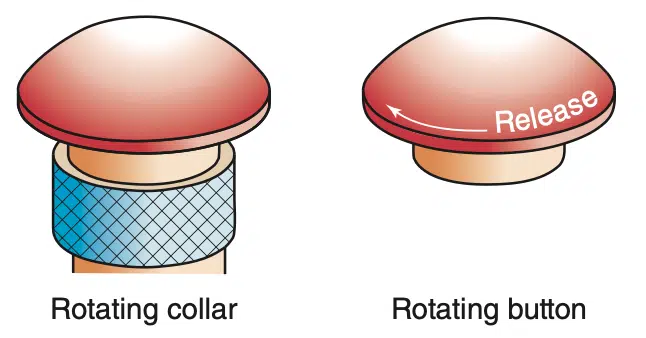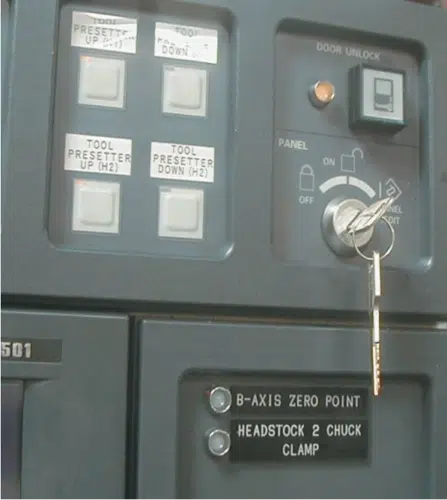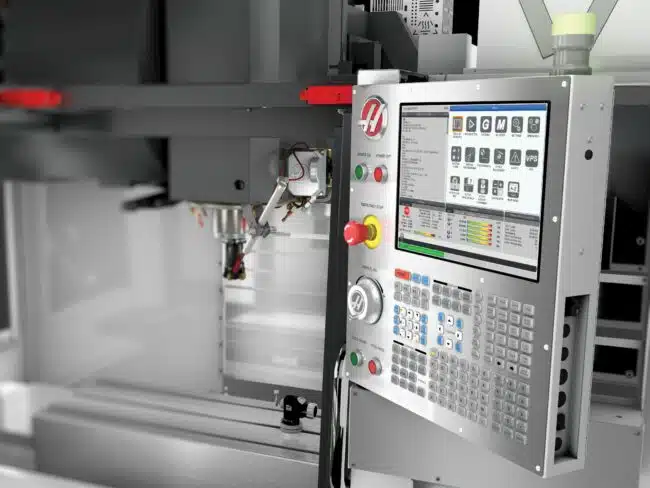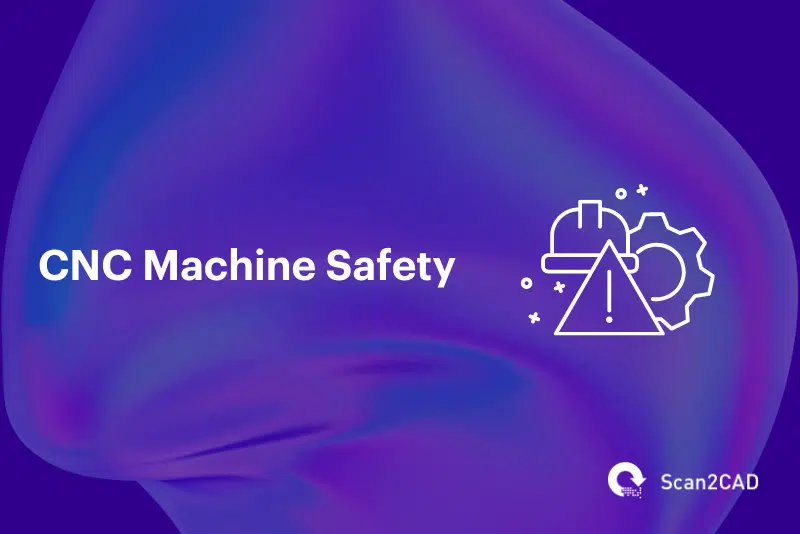Machines, along with CAM software, play a central role in automating vast swathes of the manufacturing industry. Despite this benefit, these machines present an element of risk and danger. CNC machines, for example, move at lightning-fast speeds – sometimes rotating at speeds of up to 300,000 rpm, as is the case with some micro-machining systems. Behind these breakneck speeds is a lot of electrical energy that, coupled with the sharp cutting tools, makes for extremely lethal manufacturing equipment. This necessitates CNC machine safety. Learn about the potential hazards of CNC machines, their safety features, and guidelines that will enable you to safely work with these machines, preventing accidents in the workplace.
Table of Contents
Potential Hazards of CNC Machines
CNC machines and CNC machining can be as dangerous as they are life-altering. The likelihood of exposure to conditions that can cause serious injury or death is exceptionally high. This is why it is often advisable to be extremely vigilant when working in a machine shop. The importance of vigilance emanates from the potential hazards of using CNC machines as well as the heavy materials fed into these machines. The hazards that threaten CNC machine safety include:
1. Noise
Machine shops are generally noisy. But this is expected since the cutting action, which often involves a tool made up of a hard material gliding over or grinding against another material, will naturally produce sound. However, machining is an ongoing process, given shops can run 24/7. This means that, in most cases, working in these environments translates to prolonged exposure to excessive noise levels.
Governments the world over enforce laws requiring employers to prevent or reduce risks to safety and health arising from exposure to noise at workplaces. In the United Kingdom, the Noise Regulations 2005 set the legal noise limit as 85 dBA, the same value as the United States, according to OSHA guidelines. Despite the stipulated limits, CNC machines often exceed the values. For instance, CNC lathes, milling, and drilling machines produce noise up to 104 dB, while CNC grinders can produce noise up to 134 dB.
This level of noise can be disastrous, per the Centers for Disease Control and Prevention (CDC), which notes that prolonged exposure to noise above dB may start to damage your hearing. Moreover, loud noise that exceeds 120 dB can immediately harm your hearing ability. Noise in industrial settings such as CNC machining could have been a contributing factor for some of the 14,500 people who experienced work-related hearing loss illness in 2019. Of this number, 75.9% occurred in the manufacturing industry, pointing to the danger of noise.
2. Chips
Another byproduct of the machining process is the waste material removed from the workpiece. This waste exists as metal particles, which are known as chips. Chips are an ever-present concern for machinists, who must find ways to keep these waste materials under control. They are extruded as either short or long particles, each a hazard in its own way. Generally, chips are hot immediately after they are made, reaching over 500ºC (1,000ºF). When such hot materials get into contact with synthetic clothes such as nylon and polyester, they stick, then melt through the material. As such, they can cause burns. Chips are sharp and can, therefore, cause deep or shallow cuts, especially given they fly from the surface of the workpiece at extremely fast speeds. Moreover, because they are generally made from the same strong material as the workpiece, long chips can catch and drag an unalert machinist into the machine.
3. Moving Components or Machinery
Most CNC machines (mills, drills, lathes, routers, and grinders) cut via rotating motion. Others, like CNC waterjet machines, CNC plasma cutters, CNC laser cutters, and 3D printers, also involve some motion. It is, therefore, accurate to state that CNC machines are, by their very nature, made up of moving components or machinery. These moving components can easily latch onto machinists’ sleeves, apron strings, or loose clothing, dragging them into the machine, a CNC machine safety issue.
4. Falling Heavy Objects
Large-scale or industrial-grade CNC machines are designed to work with heavy workpieces. While the role of loading the workpieces is sometimes left to a specialized crew due to the dangers involved, machinists cannot absolve themselves from certain personal responsibilities. As a machinist, you must always be watchful of your surroundings and the positioning of heavy objects, taking great care to ensure you look before moving. You should also not walk or work below suspended material or objects.
5. Heat from the Cutting Process
CNC machines, such as laser and plasma cutters, remove material by way of melting and vaporization. The heat generated during this process is in itself a hazard. Similarly, some rapid prototyping machines such as extrude hot material. In both cases, the parts will still have elevated temperatures that can cause burns, even after the machining or prototyping process is complete. Combined, these factors call for extra care when working with such material. Even so, it is equally important to tread carefully as far as the other types of CNC machines are concerned, because friction during machining can generate heat.
Safety Features of CNC Machines
Understanding the hazards associated with their equipment, manufacturers of CNC machines implement safeguards to reduce the chances of accidents and health issues. The CNC machine safety features include:
1. Safety or Containment Shield
In simple terms, a safety shield is a vapor or spray containment barrier. It prevents chips, vapor (from the cutting process), or spray (from the interaction between the cooling fluid and the rotating cutting tool) from escaping the work area. The shield is also designed to provide a safe barrier behind which the machinist can observe the cutting process.
2. Video Cameras
While the containment shield is also designed to enable the machinist to safely monitor the cutting process, it is not always effective in this regard. Sometimes, the work area gets messy, with the shield getting clouded by the cooling fluid’s spray and flying chips. However, the machinist still needs to monitor the progress of the cutting process.
To solve the visual obstruction brought by the fluid and chips, CNC machine makers include as an add-on accessory video cameras. These cameras record the activities inside the machine in real time, enabling you to track the process. They are also convenient because they ensure you are not in harm’s way. By sitting behind a monitor rather than directly in front of the cutting area, you avoid being situated along the path of flying chips or fluid.
3. Cooling fluid
Cooling fluids come in four different forms, namely petroleum oils, synthetic fluids, semi-synthetic fluids, and soluble oils. Regardless of the type, these cooling fluids are intended to serve several known functions, including:
- Reduce the external and internal heat generated by the cutting process
- Lubricating the interface between the cutter and the work material, thus reducing friction, heat, and pressure
- Reduce horsepower needed to drive the motor and cutting tool (due to reduced friction)
- Enhance tool life and service life of the machine
- Prevent oxidation on some materials
- Improve surface finish
While the cooling fluid achieves these functions, it contributes significantly to CNC machine safety. For instance, it safely and efficiently flushes away chips, which has a ripple effect. By flushing away the chips, the cooling fluid not only increases the material removal rate but also contributes to machine safety. Additionally, it prevents the chips from bunching up in the cutter flute, which can reduce the efficiency of the cutter.
4. Controller Alarm
Experienced machinists possess the necessary skills to detect many potential problems, some related to CNC machine safety. However, in some cases, the machine’s controller can announce these problems in code or words, known as alarm conditions. If the machine uses codes, the machinist must decipher what went wrong. In contrast, with words, the exact problem is displayed on the screen. Whether the controller displays a word or code depends on the model or version of the machine. Still, these alarm conditions offer insights that could prevent a disaster.
The alarm conditions can be grouped into:
- Physical and hardware errors: These are associated with the CNC machine and include, but are not limited to, low coolant, hydraulic, or lube oil; servo errors; hard limit overtravel; and more. It is these hardware-related issues that can threaten CNC machine safety.
- Syntax errors: These are errors that lie within the CNC code
5. Emergency Stop (E-Stop) Button
The emergency stop, or e-stop, button stops motion along all axes. It also stops the spindle, cooling fluid, and all other ancillary functions. Once depressed, the e-stop button stays engaged until it is manually unlocked. Also, suppose you engage this button during machine use. In that case, you must reinitialize the CNC machine, power all axis drives anew, manually move the cutter away from the workpiece, and then start over the program. For this reason, only use this button in cases where all other halt interventions are too slow to be safe.

Emergency Stop Button
6. Slide Hold Button
If you do not want to use the emergency stop button, you can press the slide hold button, which is another halt intervention. It stops motion along all axes but does not impact other functions or the program, as is the case with the e-stop button.
7. Locking Key Switch
The locking key switch, a key-protected switch on the control panel, allows the machinist to set specific levels of responsibility for the protection of people, machines, setups, and programs. For instance, the switch can be set to operate, the lowest level of responsibility. Operate allows all program run and half functions but disallows edits and setup information changes. Alternatively, the switch can be set to setup, the medium level. As the name suggests, setup allows the machinist to make setup/process changes, e.g., tool diameter and length. However, it disallows program edits. The highest level of responsibility, known as ‘edit,’ grants complete control, allowing access to all functions and setup information, as well as the ability to change existing programs and write new ones. It allows access to all functions and setup information, as well as changes to existing programs and the writing of new programs.

Key-Operated Locking Switch
8. Feed Rate and Rapid Override Buttons
The feed rate is the speed at which the cutter moves against a workpiece. On the other hand, rapid travel refers to the fastest speed at which a CNC machine can move the cutting tool from one position to another. Given that these speeds can be extremely fast, manual override buttons are necessary to safeguard CNC machine safety.
Machinists use the feed rate and rapid override buttons to protect against poorly written programs. How so? Usually, these buttons allow machinists to manually adjust the feed rate or rapid travel speed downward based on pre-set figures. For instance, the button can be set to reduce the speed to zero or a certain percentage of the maximum speed. These buttons come in handy when machinists observe unusual speeds.
9. Automated Chip Removal Conveyors
In large-scale machining operations, the equipment is constantly processing numerous workpieces. This means the machines generate a large quantity of chips within a short time. Coupled with the fast-moving machinery, the constant flow of cooling fluid, and the containment shield, this makes manual chip removal quite hazardous. To improve CNC machine safety, manufacturers often include automated chip removal conveyors. As the name suggests, these crucial components automatically remove chips from the work area, carting them to a collection bin for recycling or disposal.
Essential Safety Guidelines for Operating CNC Machines
While CNC machine manufacturers strive to safeguard CNC machine safety, the onus is still on the machinists to take extra care. To avoid work-related incidences, we have compiled essential safety guidelines for operating CNC machines, as below:
1. Always Use Personal Protective Equipment (PPE)
Despite its effectiveness, the containment shield cannot guarantee 100% CNC machine safety. This is because you are likely to walk through sections of the machine shop that house machines that might not have the shield. Additionally, some grinding equipment, such as grinders that use grinding discs, do not come with containment shields. At the same time, the shop is a noisy place. And as we have discussed earlier, the probability of losing your hearing increases with every minute you spend in the noisy shop. In this regard, it is advisable to use personal protective equipment such as safety glasses, full-face shields, gloves, and hearing protection.
2. Properly Secure Workpieces
Loose workpieces can easily detach from their harnesses and fly away, hitting and damaging crucial components inside the CNC machine or the containment shield. They can also damage the cutting tools and result in poor-quality machining. Thus, properly securing all workpieces can minimize the risk of accidents, upholding CNC machine safety.
3. Put on Well-Fitting Clothes
As previously mentioned, working around moving machinery poses a risk. Therefore, it is always advisable to protect yourself by putting on well-fitting clothes that will not get tangled in the moving parts. Your clothes should have no sleeves, pockets, or tie strings/cords. Plus, you should always tuck in your shirts.
4. Wear Clothes with Natural fibers
Natural fibers like wool or cotton in clothing provide a protective barrier against hot flying chips. They do not burn through upon getting into contact with the chips. By contrast, synthetic fibers melt.
5. Always Wear Steel-Toe Boots or Shoes
Regardless of how careful you are, you may not always foresee certain risks. One such inevitability is falling heavy objects. For this reason, wearing steel-toe boots is better than putting on regular shoes. The former protects your toes, preventing injuries.
6. Avoid Accessories
Do not wear accessories such as necklaces and bracelets, which might get caught in the moving machinery.
7. Tie Your Hair Up
Much like how toddlers grab onto long hair, moving machinery can do the same, but with much more force. The ease with which loose hair can get tangled in such machinery does not help. You might lose a few strands of hair at best, and at worst, you might get sucked into the machine head first. To prevent such a disaster, always tie your hair up or cover it.
8. Have an Emergency Action Plan
Given that machines in workshops move at high speeds, emergencies are not uncommon. Similarly, crashes can occur, given that most materials and machines are extremely heavy. That said, the ability of an operator to maneuver through these issues by following an action plan depends on pre-planning and practice.
The issues can be categorized into three levels. The first includes non-emergency incidents that might get worse over time. The second level encompasses low-level emergencies, such as chip build-up, that might degrade with time. The third level covers a situation that is extremely dangerous to the machine and operator. Each of these incidents should have an action plan, with the third level requiring the operator to immediately hit the e-stop button.

Haas Controller with E-Stop Button for CNC Machine Safety (source)
9. Monitor Cutting Progress
The transparent CNC machine safety shield is intended to ensure the operator can monitor the progress of the machining process. In cases where the view is obstructed by a mixture of the flying chips and cooling fluid, a video camera is provided. But these are not the only avenues through which you can monitor the progress. You should also pay attention to the sound made.
The logic behind constantly monitoring the progress is to notice abnormal movements or sounds that might threaten your health and safety. Then, depending on the severity of the issue (which you will have documented in your emergency action plan), you can use the slide hold button, feed rate and rapid override buttons, or e-stop buttons.
10. Perform Routine Inspection and Maintenance
Routine maintenance can help you prevent certain issues from escalating. It solves issues at their formative stages, nipping them in the bud. For instance, by maintaining the hydraulic or cooling fluid pump, you can avoid a potential explosion or failure that can otherwise cause a level-three emergency. Similarly, regularly servicing the chip conveyor can help you avoid a breakdown that might lead to chip build-up, a level-two issue. Put simply, routine maintenance promotes CNC machine safety.
Training and Education for CNC Machine Safety
In many countries, including the UK and USA, the standards require employers to conduct employee training at least once every 12 months. Such training achieves the following:
- Educate supervisors, workers, and managers about recognizing and mitigating potential hazards
- Equip employees with the knowledge to accurately report and control hazards
- Aid professionals in working both productively and safely
- Enhance understanding of CNC machine safety and machine shop health and safety programs. With this understanding, workers and managers can contribute to their improvement, development, and implementation
Implementing a Safe CNC Machine Environment
Hazards directly affecting CNC machine safety, i.e., machine hazards, are only one piece of the puzzle. Others include:
- Electrical hazards, including shocks and fires, resulting from faulty wiring, damaged insulation, improper grounding, or power surges
- Chemical hazards from exposure to coolants, metal dust, lubes, and solvents, leading to skin irritation, allergies, respiratory issues, etc.
- Waste management: it is important to consider how you dispose of waste such as used oils, coolant, chips, and unwanted material from the machined workpiece
Taking each of these factors into consideration and implementing the best industry practices contributes to a safe CNC machine environment. For this to succeed, management must establish a safety culture. After all, the managers are supposed to develop specific training for each CNC machine equipment in a shop and adopt additional safety rules as necessary.
Conclusion
Accidents in machine shops are not unheard of, given that the CNC machines are heavy and rotate at high speed, not to mention they sometimes work on heavy materials. It is, therefore, crucial to implement CNC machine safety guidelines and best practices to prevent such accidents. For a start, modern machines come with safety features. Nonetheless, they do not guarantee 100% safety. However, the responsibility for safety still lies with the operator or machinist. They must wear PPE, perform regular inspections and maintenance, wear suitable clothing, avoid accessories, have an emergency action plan, and more. Furthermore, participation in safety training and education is crucial to maintaining a safe CNC machine shop environment.

